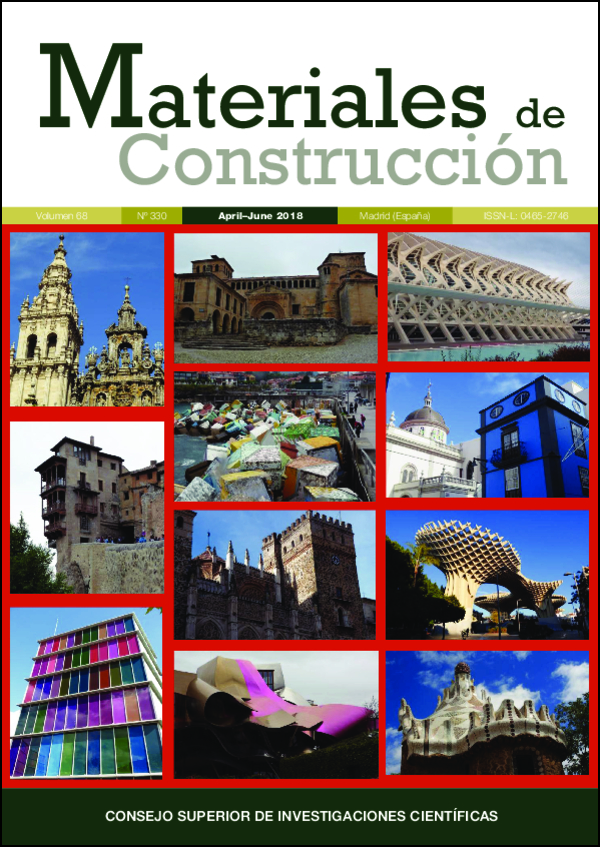Ultrafine portland cement performance
DOI:
https://doi.org/10.3989/mc.2018.03317Keywords:
Portland cement, Silica fume, Compressive Strength, Hg Porosimetry, Thermal analysisAbstract
By mixing several binder materials and additions with different degrees of fineness, the packing density of the final product may be improved. In this work, ultrafine cement and silica fume mixes were studied to optimize the properties of cement-based materials. This research was performed in mortars made of two types of cement (ultrafine Portland cement and common Portland cement) and two types of silica fume with different particle-size distributions. Two Portland cement replacement ratios of 4% and 10% of silica fume were selected and added by means of a mechanical blending method. The results revealed that the effect of the finer silica fume mixed with the coarse cement enhances the mechanical properties and pore structure refinement at a later age. This improvement is somewhat lower in the case of ultrafine cement with silica fume.
Downloads
References
Sanjuán, M.A.; Menéndez, E.; Argiz ,C.; Moragues, A. (2016) Coal bottom ash research program focused to evaluate a potential portland cement constituent. In: Proceedings of II International Conference on Concrete Sustainability. Madrid, Spain, June, 532-543.
Bentz, D.P.; Haecker, C.J. (1999) An argument for using coarse cements in high performance concretes. Cem. Concr. Res. 29[4], 615–618. https://doi.org/10.1016/S0008-8846(98)00201-4
Sanjuán, M.A.; Argiz, C.; Gálvez, J.C.; Moragues, A. (2015) Effect of silica fume fineness on the improvement of Portland cement strength performance. Constr. Build. Mater. 96, 55–64. https://doi.org/10.1016/j.conbuildmat.2015.07.092
Kuhlmann, K.; Ellerbrock, H.G.; Sprung, S. (1985) Particle-size distribution and properties of cement. Part I: Strength of portland cement. ZKG International Cement-Lime-Gypsum. Edition B. 38[4], 169–178.
Thomas, J.J.; Jennings, H.M.; Chen, J.J. (2009) Influence of Nucleation Seeding on the Hydration Mechanisms of Tricalcium Silicate and Cement. J. Phys. Chem. C. 113 [11], 4327–4334. https://doi.org/10.1021/jp809811w
Goldman, A.; Bentur, A. (1993) The influence of microfillers on enhancement of concrete strength. Cem. Concr. Res. 23 [4], 962–972. https://doi.org/10.1016/0008-8846(93)90050-J
Feng, N.Q.; Shi, Y.X.; Hao, T.Y. (2000) Influence of ultrafine powder on the fluidity and strength of cement paste. Adv. Cem. Res. 12 [3], 89–95. https://doi.org/10.1680/adcr.2000.12.3.89
Roux, N.; Andrade, C.; Sanjuán, M. (1996) Experimental Study of Durability of Reactive Powder Concretes. J. Mater. Civ. Eng. 8 [1], 1–6. https://doi.org/10.1061/(ASCE)0899-1561(1996)8:1(1)
Fernández, A.; Alonso, M.C.; García –Calvo, J.L.; Lothenbach, B. (2016) Influence of the synergy between mineral additions and Portland cement in the physical-mechanical properties of ternary binders. Mater. Construcc. 66 [324], October- December e097. https://doi.org/10.3989/mc.2016.10815
EN 197-1:2011 Cement - Part 1: Composition. specifications and conformity criteria for common cements.
EN 196-1:2016 Methods of testing cement - Part 1: Determination of strength. European Committee for Standardization (CEN). Brussels.
EN 196-2:2013 Method of testing cement. Chemical analysis of cement.
UNE 83988-1:2008 Concrete durability. Test methods. Determination of the electrical resistivity. Part 1: Direct test (reference method). AENOR. Madrid.
Tobón, J.I.; Payá, J.; Borrachero, M.V.; Soriano, L.; Restrepo, O.J. (2012) Determination of the optimum parameters in the high resolution thermogravimetric analysis (HRTG) for cementitious materials. J. Therm. Anal. Calorim.107 [1], 233–239. https://doi.org/10.1007/s10973-010-0997-0
Kong, D.Y.; Du, X.F.; Wei, S.; Zhang, H.; Yang, Y.; Shah, S.P. (2012) Influence of nano-silica agglomeration on microstructure and properties of the hardened cement-based materials. Constr. Build. Mater. 37, 707–715. https://doi.org/10.1016/j.conbuildmat.2012.08.006
Bonavetti, V.L.; Castellano, C.; Donza, H.; Rahhal, V.F.; Irassar, E.F. ((2014) Cement with silica fume and granulated blast-furnace slag: strength behavior and hydratation. Mater. Construcc. 64 [315], July-September e25. https://doi.org/10.3989/mc.2014.04813
Poon, C.S.; Kou, S.C.; Lam, L. (2006) Compressive strength chloride diffusivity and pore structure of high performance metakaolin and silica fume concrete. Constr. Build. Mater. 20 [10], 858–865. https://doi.org/10.1016/j.conbuildmat.2005.07.001
Elahi, A.; Basheer, P.A.M.; Nanukuttan, S.V.; Khan, Q.U.Z. (2010) Mechanical and durability properties of high performance concretes containing supplementary cementitious materials. Constr. Build. Mater. 24 [3], 292–299. https://doi.org/10.1016/j.conbuildmat.2009.08.045
Mazloom, M.; Ramezanianpour, A.A.; Brooks, J.J. (2004) Effect of silica fume on mechanical properties of high-strength concrete. Cem. Concr. Compos. 26 [4], 347–357. https://doi.org/10.1016/S0958-9465(03)00017-9
Senhadji Y, Escadeillas G, Mouli M, Khelafi H, Benosman. (2014) Influence of natural pozzolan silica fume and limestone fine on strength acid resistance and microstructure of mortar. Powder Technol. 254, 314–323. https://doi.org/10.1016/j.powtec.2014.01.046
Wang, A.Q.; Zhang, C.Z.; Zhang, N.S. (1999) The theoretic analysis of the influence of the particle-size distribution of cement system on the property of cement. Cem. Concr. Res. 29 [11], 1721–1726. https://doi.org/10.1016/S0008-8846(99)00148-9
Mahmoud, S.; Reyes, E.; Moragues, A. (2010) Evolution of microstructure and mechanical behavior of concretes utilized in marine environments. Mater. Des. 31[7], 3412-3418. https://doi.org/10.1016/j.matdes.2010.01.045
Huang, C.Y.; Feldman, R.F. (1985) Hydration reactions in portland cement-silica fume blends. Cem. Concr. Res. 15[4], 585–592. https://doi.org/10.1016/0008-8846(85)90056-0
Langan, B.W.; Weng. K.; Ward, M.A. (2002) Effect of silica fume and fly ash on heat of hydration of Portland cement. Cem. Concr. Res. 32[7], 1045–51. https://doi.org/10.1016/S0008-8846(02)00742-1
Published
How to Cite
Issue
Section
License
Copyright (c) 2018 Consejo Superior de Investigaciones Científicas (CSIC)

This work is licensed under a Creative Commons Attribution 4.0 International License.
© CSIC. Manuscripts published in both the print and online versions of this journal are the property of the Consejo Superior de Investigaciones Científicas, and quoting this source is a requirement for any partial or full reproduction.
All contents of this electronic edition, except where otherwise noted, are distributed under a Creative Commons Attribution 4.0 International (CC BY 4.0) licence. You may read the basic information and the legal text of the licence. The indication of the CC BY 4.0 licence must be expressly stated in this way when necessary.
Self-archiving in repositories, personal webpages or similar, of any version other than the final version of the work produced by the publisher, is not allowed.
















